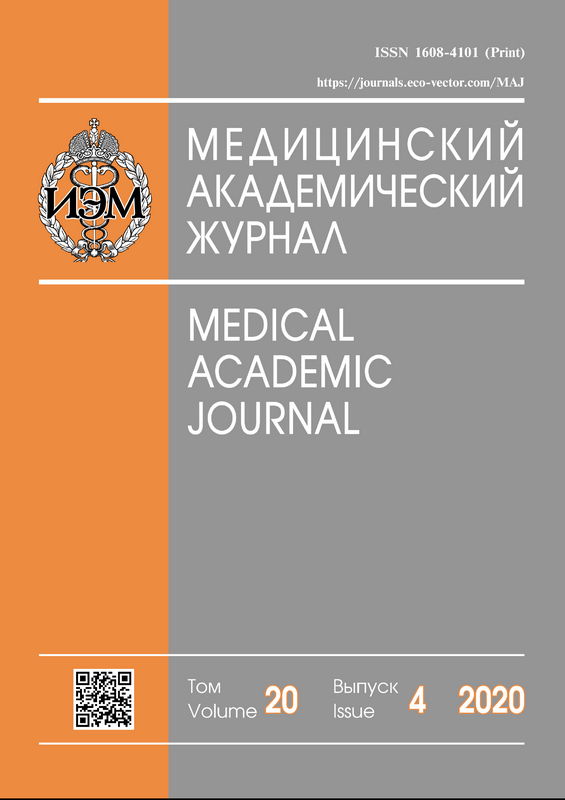Evaluate the role of mercury chloride in the development of toxic pulmonary edema in laboratory animals during intoxication with substances of acylating action
- Authors: Tolkach P.G.1, Basharin V.A.1, Chepur S.V.2, Sizova D.T.3, Vengerovich N.G.2
-
Affiliations:
- Military Medical Academy named after S.M. Kirov, the Ministry of Defense of the Russian Federation
- State Scientific Research Testing Institute of Military Medicine of the Ministry of Defense of the Russian Federation
- Military unit 33952, the Ministry of Defense of the Russian Federation
- Issue: Vol 20, No 4 (2020)
- Pages: 55-61
- Section: Original research
- Published: 18.03.2021
- URL: https://journals.eco-vector.com/MAJ/article/view/50133
- DOI: https://doi.org/10.17816/MAJ50133
- ID: 50133
Cite item
Abstract
Relevance. Intoxication of acylate pulmonotoxicants causes disturbance of structure and function of air-blood barrier, the output of liquid in the interstitial and alveolar space and manifestation of lung edema. Aquaporins play an important role in the transportation of fluid through the alveolar-capillary membrane, including pathological conditions. Water permeability through aquaporins is blocked by mercury ions. Using mercury chloride may reduce severity of the acute lung edema after intoxication of the pulmonotoxicants.
Intention. The goal is to evaluate the role of mercury dichloride in the development of toxic pulmonary edema in laboratory animals during intoxication with pulmonotoxicants with an acylating effect.
Methodology. Laboratory animals (rats and rabbits) were exposed to inhalation intoxication of carbonic acid dichloride and perfluoroisobutylene at concentrations of 1,5LC50. In 30 minutes after exposure were administrated of 0,3LD50 mercury chloride to the animals subcutaneously. The oxygenation index, acid-base state, pulmonary coefficient, histological changes in lung was investigated in 6 hours after exposure.
Results. It was found that intoxication with carbonic acid dichloride and perfluoroisobutylene at concentrations of 1,5LC50 led to the development of toxic pulmonary edema in rats and rabbits 6 hours following exposure. The administration mercury chloride to 30 minutes following exposure to the pulmonotoxicants under study, led to a decrease (p < 0.05) in the pulmonary coefficient, an increase (p < 0.05) in the oxygenation index and normalization of the acid-base state according to compared with animals receiving 0.9 % NaCl following intoxication. When conducting a histological examination, in animals treated with mercury chloride less pronounced changes in the histoarchitectonics of the lung tissue were noted.
Conclusion. Considering the fact that the administration of mercury chloride to animals led to a decrease in the manifestations of pulmonary edema in animals, it was suggested that aquaporins play an important role in the pathogenesis of toxic pulmonary edema caused by intoxication with pulmonotoxicants with an acylating effect. The use of selective blockers of aquaporins (less toxic than mercury chloride) may be a new direction in the pathogenetic therapy of toxic pulmonary edema due to exposure to pulmonotoxicants.
Full Text
About the authors
Pavel G. Tolkach
Military Medical Academy named after S.M. Kirov, the Ministry of Defense of the Russian Federation
Author for correspondence.
Email: pgtolkach@gmail.com
ORCID iD: 0000-0001-5013-2923
PhD Med. Sci., lecturer of the Department of Military Toxicology and Medical Protection
Russian Federation, Saint PetersburgVadim A. Basharin
Military Medical Academy named after S.M. Kirov, the Ministry of Defense of the Russian Federation
Email: pusher6@yandex.ru
Dr. Med. Sci., Prof., Head of Department of Military Toxicology and Medical Protection
Russian Federation, Saint PetersburgSergey V. Chepur
State Scientific Research Testing Institute of Military Medicine of the Ministry of Defense of the Russian Federation
Email: pusher6@yandex.ru
Dr. Med. Sci., Prof., Head
Russian Federation, Saint PetersburgDarya T. Sizova
Military unit 33952, the Ministry of Defense of the Russian Federation
Email: pusher6@yandex.ru
doctor
Russian Federation, KhankalaNicolay G. Vengerovich
State Scientific Research Testing Institute of Military Medicine of the Ministry of Defense of the Russian Federation
Email: pusher6@yandex.ru
Dr. Med. Sci., the Deputy Head of Department
Russian Federation, Saint PetersburgReferences
- Holmes WW, Keyser BM, Paradiso DC, et al. Conceptual approaches for treatment of phosgene inhalation-induced lung injury. Toxicol Lett. 2016;244:8–20. https://doi.org/ 10.1016/j.toxlet.2015.10.010.
- Zhang YL, Fan L, Xi R, et al. Lethal concentration of perfluoroisobutylene induced acute lung injury in mice mediated via cytokins storm, oxidative stress and apoptosis. Inhal Toxicol. 2017;29(6):255–265. https://doi.org/10.1080/08958378.2017.1357772.
- Sciuto AM, Hurt HH. Therapeutic treatments of phosgene-induced lung injury. Inhal Toxicol. 2004;(16):565–580. https://doi.org/10.1080/08958370490442584.
- Zhao J, Shao Z, Zhang X, et al. Suppression of perfluoroisobuthylene induced acute lung injury by pretreatment with pyrrolidine dithiocarbamate. J Occup Health. 2007;(49):95–103. https://doi.org/10.1539/joh.49.95.
- Zea B, Verkman AS. Lung edema clearance: 20 years of progress invited review: Role of aquaporin water channels in fluid transport in lung and airways. J Appl Physiol. 2002;93(6):2199–2206. https://doi.org/10.1152/japplphysiol.01171.2001.
- Jung J, Preston G, Smith B, et al. Molecular structure of the water channel through aquaporin CHIP. The hourglass model. J Biol Chem. 1994;269(20):14648–14654.
- King LS, Agre P. Pathophysiology of the aquaporin water channels. Amn Rev Phpiol. 1996;58:619–648. https://doi.org/10.1146/annurev.ph.58.030196.003155.
- Hirano Y, Okimoto N, Kadohira I, et al. Molecular mechanisms of how mercury inhibits water permeation through aquaporin-1: Understanding by molecular dynamics simulation. Biophys J. 2010;98(8):1512–1519. https://doi.org/ 10.1016/j.bpj.2009.12.4310.
- Гриппи М.А. Патофизиология легких. – 2-е изд. – М.: Бином, 2005. – 304 с. [Grippi MA. Pulmonary pathophysiology. 2nd ed. Moscow: Binom; 2005. 304 p. (In Russ.)]
Supplementary files









